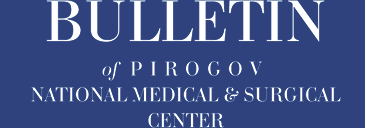Authors
Mukhiddinov N.D.1, Abdullozoda F.A.1, Boltuev K.H.1, Ruziboyzoda K.R.2
1 State Education Establishment “Institute of Postgraduate Education in Health Sphere of the Republic of Tajikistan” Dushanbe, Republic of Tajikistan
2 State educational institution «Avicena Tajik State Medical University» Dushanbe, Republic of Tajikistan
Abstract
Purpose of the study. Improving methods for preventing the development of dysphagia after laparoscopic fundoplication in patients with hiatal hernia.
Material and methods. A comprehensive analysis of diagnostic data and results of surgical treatment of 140 patients with a diagnosed hiatal hernia (HH) was carried out. According to the study design, the patient cohort was stratified into two groups. The control group consisted of 67 patients who underwent traditional open surgery. The main group included 73 patients who underwent videolaparoscopic correction of the НН using developed methods for the prevention of postoperative dysphagia.
Results. In the control group (n = 67), surgical correction of the НН was carried out through a classic laparotomy approach using standard surgical techniques. In the main group (n = 73), in 68 (93.2%) cases, various modifications of videolaparoscopic fundoplication with posterior crurorrhaphy were used. Only 5 (6.8%) patients, according to strict indications, underwent laparotomy operations with Nissen fundoplication in a clinical modification, also with posterior crurorrhaphy. In order to prevent dysphagia of varying severity, the mesh prosthesis was covered with a strand of omentum. Also, during videolaparoscopic Nissen fundoplication, the formation of a soft cuff was used using a Blackmore probe to dose the degree of tension of the fundoplication. Analysis of postoperative complications demonstrated significant differences between the study groups regarding the incidence of dysphagia. In the main group, dysphagia of varying intensity was recorded in only 4 patients, which amounted to 5.5% of the total number of observations. In the control group, this complication occurred much more often – in 13 patients (19.4%).
Conclusion. Thus, the obtained statistical data convincingly demonstrate the clinical effectiveness of the developed set of preventive measures in preventing the development of mechanical dysphagia in the postoperative period.
Keywords: hiatal hernia, laparoscopic fundoplication, postoperative dysphagia, prevention.
References
1. Borodkin IN, Demin DB, Lyashchenko SN, Fayzulina RR, Savin DV. Complications of laparoscopic interventions for hiatal hernias. Endoscopic surgery. 2022; 28(1): 57-64. (In Russ.)
2. Ablaev EE, Belyalova AR, Ibragimova NK. Nissen fundoplication is the “gold standard” for surgical treatment of hiatal hernias. Scientific news. 2022; 28: 88-90. (In Russ.)
3. Burmistrov MV, Bebezov SI. Results of repeated endosurgical operations in patients with achalasia cardia and hiatal hernia. Znanstvena Misel. 2022; 6: 21-27. (In Russ.)
4. Fedorov VI, Burmistrov MV. Analysis of the results of reconstructive operations for relapse of gastroesophageal reflux disease and hiatal hernia. Volga Oncology Bulletin. 2023; 1(53): 18-28. (In Russ.)
5. Mazer L, Telem DA. Paraesophageal Hernia: Current Management. Adv, Surg. 2021; 55: 109-122.
6. Grintsov AG, Ishchenko RV, Sovpel IV, Sovpel OV, Balaban VV. Reasons for unsatisfactory results after laparoscopic repair of hiatal hernias. Research and practice in medicine. 2021; 8(1): 40-52. (In Russ.)
7. Ishchenko RV, Sovpel IV, Grintsov AG, Sovpel OV. The effectiveness of using mesh implants in laparoscopic repair of hiatal hernias. Surgical practice. 2020; 1(41): 33-44. (In Russ.)
8. Rajkomar K, Berney CR Large hiatus hernia: time for a paradigm shift? BMC Surg. 2022; 22(1): 264.
9. Onnitsev IE, Chuprina AP. The choice of surgical tactics for hiatal hernia. Medical Bulletin of the GVKG named after. N.N. Burdenko. 2021; 3(5): 41-49. (In Russ.)
10. Rosenfeld II. Current problems of surgical treatment of large and giant hiatal hernias. Russian Medical Journal. 2021; 27(3): 291-298. (In Russ.)
11. Sivets NF. Long-term results of surgical treatment of hiatal hernias. Healthcare (Minsk). 2022; 9(906): 38-50. (In Russ.)
12. Sovpel IV, Zolotukhin SE, Sovpel OV, et al. Repeated surgical interventions after laparoscopic repair of hiatal hernias. Neoplasm (Neoplasm). 2023;1 (40):23-31. (In Russ).
13. DeMeester SR. Laparoscopic Hernia Repair and Fundoplication for Gastroesophageal Reflux Disease. Gastrointest. Endosc. Clin. N. Am. 2020; 30(2): 309-324.


